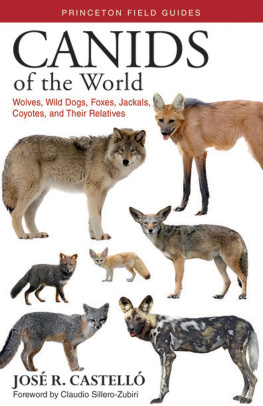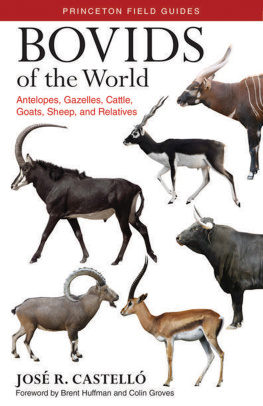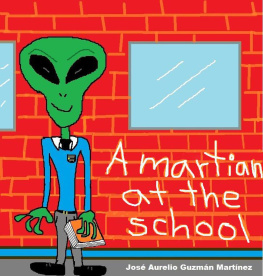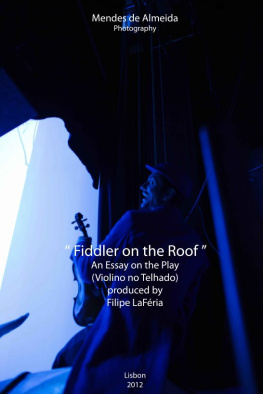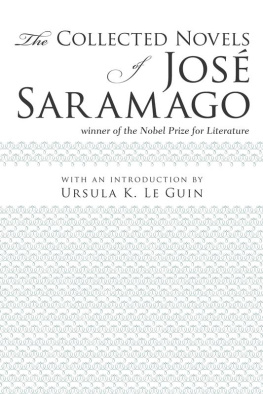Castelló José R. - Canids of the World
Here you can read online Castelló José R. - Canids of the World full text of the book (entire story) in english for free. Download pdf and epub, get meaning, cover and reviews about this ebook. year: 2018, publisher: Princeton University Press, genre: Romance novel. Description of the work, (preface) as well as reviews are available. Best literature library LitArk.com created for fans of good reading and offers a wide selection of genres:
Romance novel
Science fiction
Adventure
Detective
Science
History
Home and family
Prose
Art
Politics
Computer
Non-fiction
Religion
Business
Children
Humor
Choose a favorite category and find really read worthwhile books. Enjoy immersion in the world of imagination, feel the emotions of the characters or learn something new for yourself, make an fascinating discovery.
- Book:Canids of the World
- Author:
- Publisher:Princeton University Press
- Genre:
- Year:2018
- Rating:3 / 5
- Favourites:Add to favourites
- Your mark:
- 60
- 1
- 2
- 3
- 4
- 5
Canids of the World: summary, description and annotation
We offer to read an annotation, description, summary or preface (depends on what the author of the book "Canids of the World" wrote himself). If you haven't found the necessary information about the book — write in the comments, we will try to find it.
Canids of the World — read online for free the complete book (whole text) full work
Below is the text of the book, divided by pages. System saving the place of the last page read, allows you to conveniently read the book "Canids of the World" online for free, without having to search again every time where you left off. Put a bookmark, and you can go to the page where you finished reading at any time.
Font size:
Interval:
Bookmark:

CANIDS OF THE WORLD
Wolves, Wild Dogs, Foxes, Jackals, Coyotes, and Their Relatives
Jos R. Castell
Foreword by
Claudio Sillero-Zubiri
PRINCETON UNIVERSITY PRESS
PRINCETON AND OXFORD
Copyright 2018 by Jos R. Castell
Copyright of the photographs remains with the individual photographers
Published by Princeton University Press,
41 William Street, Princeton, New Jersey 08540
In the United Kingdom: Princeton University Press, 6 Oxford Street,
Woodstock, Oxfordshire OX20 1TR
nathist.princeton.edu
Requests for permission to reproduce material from this work should be sent to
All rights reserved.
Library of Congress Control Number : 2017963961
ISBN 978-0-691-18372-5
ISBN (pbk.) 978-0-691-17685-7
British Library Cataloging-in-Publication Data is available
Production and design by Jos R. Castell, Madrid, Spain
This book has been composed in Helvetica Neue
Printed on acid-free paper
Printed in China
10 9 8 7 6 5 4 3 2 1
CONTENTS
FOREWORD
While most people would know what a Fox, Wolf, Jackal or Wild Dog may look like, and we can agree that they all share an easily distinguishable Dog morph, some members of the family Canidae are not so well known, even to the most dogged Dog enthusiast. Let alone the rich and diverse social structure and behavior displayed by Canid species distributed worldwide, and their ability to occupy most habitats. The typically tall, lithe Canid body, bushy tail and long limbs with digitigrade four-toed feet are adaptions to the cursorial pursuit of prey in open environments. This is matched up with a flexible dietfrom an almost exclusive emphasis on frugivory or insectivory, to omnivory to strict carnivoryand an opportunistic and adaptable behavior, and there is a complex social organization with much variation within and between species.
To understand them fully, and thereby to appreciate their wonder, one must know several snippets of Canid natural history. Perhaps most revealing in this quest are the many long-term studies in which field biologists have often spent half a lifetime, burrowed deep into the intricate detail of the behavior of a particular species in the wild. As a fun alternative to a scholarly sabbatical in a library, this field guide presents many interesting facts and vignettes of the ecology and behavior of these animals, guaranteed to engage the readerwhether an enthusiast or a scholarin getting to the gist of what it means to be a wild Canid.
Wolves and their canine relatives have always held a fascination to humankind. Dogs are surely our first domestic animals. The history regarding the location of their transformation from Wolves, and the peoples responsible for it, has been intriguing but also confusing, with recent genetic evidence pointing to Europe, the Far East and places in between. A tribute to that is the close connection that persists between Domestic Dogs, wild Canids and culture, with many examples in the arts and literature. Genetically and behaviorally, the closeness between Domestic Dogs and some Canis species is such that they may even interbreed, although these events may be rarer than previously thought.
Wild Canids seem to have an exceptional capacity to evoke strong feelings of charm, affinity or loathing in human onlookers. People are especially attuned to Canid communication signals and use of extensive postural, vocal and olfactory signals because we are so frequently their recipient from our Domestic Dogs. Although domestication has affected the Dogs repertoire, the barks, growls, whines and howls of Wolves are ever present in our daily lives.
Partly due to this fascination, wild Canids command attention that is disproportionate to their species diversity or abundance, chiefly because they so frequently and successfully challenge human interests. They will often compete with humans as predators, since they find human-raised livestock irresistible prey, and often prey on game species. Rarely, a few of the larger species may occasionally even maul or kill people. And more recently, their role as vectors of diseases that can be harmful to people and their domestic animals has been highlighted. For those reasons Canids have borne a high proportion of the conflict between humans and carnivores. The more prolific and adaptable Canids, like Red Foxes, Jackals and Coyotes, have fared well despite this competition.
The contemporary Canidae is the most widespread family of extant Carnivora, with at least one species present on all continents except Antarctica. They range from deserts to ice fields, from mountains to swamps or grasslands, and from rain forests to urban jungles. To do this they may travel home ranges as small as the Island Fox (0.5 km2) or as large and non-defensible as the African Wild Dog (up to 2,000 km2).
Those familiar with taxonomy will not be surprised to know that even the question of the exact number of Canid species remains unresolved, but we tend to agree that there are at least 37 living Canids in 13 genera. These include three ancient Wolves recently recognized as species in their own right, namely the African, Himalayan and Indian Wolves. Recognition of the Eastern Wolf Canis lycaon in North America would add another. Overall the main clades within the Canidae are well resolved, although there are still a few loose ends, as exemplified by unresolved African Jackal taxonomy and the species status of the Red Wolf. Intriguingly, the ability of Canis species to hybridize would suggest an important role for genetic admixture in lupine Canid evolution.
The distribution of Canidae species may be highly restricted, and a species may be endemic to one country or even a small fraction of onealmost the entire Darwins Fox population occurs only on Chilo island off the Chilean mainland, Island Fox subspecies occur on one island each, and Ethiopian Wolves are found only above 3,000 m a.s.l. in a few mountain enclaves in the Ethiopian highlands. At the other end of the spectrum other Canid species span several continents; for instance the Gray Wolf was until a century ago the most widely distributed terrestrial mammal. Its successor to the throne is the wily and thriving Red Fox, covering nearly 70 million km2 across the entire Northern Hemisphere and introduced to Australia in the 1800s.
Somewhere in the middle in terms of size, and almost as numerous, we find the more prolific and adaptable Canids. Coyotes rule in North America, Lycalopex zorros are ubiquitous in the southern cone of South America and Jackals command vast areas of Africa and Asia. These meso-carnivores have fared well despite competition, while the larger mob operators or pack hunterse.g., African Wild Dogs and Dholesand the more specialized members of the family, like the Ethiopian Wolf, Bat-Eared Fox and Darwins Fox, have become rarer and are often threatened with extinction.
Almost all Canids live together in territorial groups, either as monogamous pairs or as larger units enhanced by the delayed dispersal of offspring. These larger packs share a common territory, tend to engage in cooperative breeding, have more than one breeding female, and include non-reproductive adults, which may benefit the breeders fitness through allosuckling, babysitting, feeding the pups or through territorial defense.
What is not up for debate is that the Canids, from the largest Gray Wolf to the puny Fennec Fox or Blanfords Fox, comprise a fascinating and beautiful assortment of animals, with many intriguing adaptations and social behaviors. Jos R. Castell has brought out the most interesting facts about these animals, and illustrated this guide with wonderful photographs and artwork. By depicting them against the white page he achieves the same effect of field-guide illustrations, but gives the reader the extra excitement of looking at an actual live animal.
Next pageFont size:
Interval:
Bookmark:
Similar books «Canids of the World»
Look at similar books to Canids of the World. We have selected literature similar in name and meaning in the hope of providing readers with more options to find new, interesting, not yet read works.
Discussion, reviews of the book Canids of the World and just readers' own opinions. Leave your comments, write what you think about the work, its meaning or the main characters. Specify what exactly you liked and what you didn't like, and why you think so.

